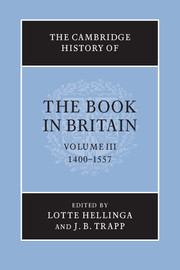Book contents
- Frontmatter
- Introduction
- 1 Literacy, books and readers
- TECHNIQUE AND TRADE
- COLLECTIONS AND OWNERSHIP
- 9 Private ownership of printed books
- 10 Monastic libraries: 1400–1557
- 11 The early royal collections and the Royal Library to 1461
- 12 The Royal Library from Edward IV to Henry VII
- 13 The Royal Library under Henry VIII
- READING AND USE OF BOOKS
- Appendix
- List of abbreviations
- Bibliography
- Photo credits
- General index
- Index of manuscripts
- Bibliographic index of printed books
- Plate Section"
- References
10 - Monastic libraries: 1400–1557
from COLLECTIONS AND OWNERSHIP
Published online by Cambridge University Press: 28 March 2008
- Frontmatter
- Introduction
- 1 Literacy, books and readers
- TECHNIQUE AND TRADE
- COLLECTIONS AND OWNERSHIP
- 9 Private ownership of printed books
- 10 Monastic libraries: 1400–1557
- 11 The early royal collections and the Royal Library to 1461
- 12 The Royal Library from Edward IV to Henry VII
- 13 The Royal Library under Henry VIII
- READING AND USE OF BOOKS
- Appendix
- List of abbreviations
- Bibliography
- Photo credits
- General index
- Index of manuscripts
- Bibliographic index of printed books
- Plate Section"
- References
Summary
The century and a half from 1400 to the Dissolution of the Monasteries is one of the most interesting in the history of monastic libraries. It is dominated by the introduction of the New Learning and the invention of printing with movable type, but the period also witnessed the full impact of the universities, a growing dissatisfaction with the Church and a corresponding increase in private devotion, a dramatic improvement in vernacular literacy, and the dissemination of a great deal of religious literature in English. Indeed, it is perhaps an anomaly that the fifteenth century, which has been termed (not without some justice) ‘a literary desert’, should also have been a period in which we see, as Derek Pearsall says, ‘an increase in the demand for, availability and ownership of books of all kinds’.
Let us begin our investigation with a glance at the source-materials at our disposal. N. R. Ker and A. G. Watson have drawn our attention to about forty-four records of books in monastic libraries for the period in which we are interested. I exclude for the moment the lists compiled by John Leland. Most of these records are incomplete. Many are concerned only with donations or bequests; some list only the books in the church; some are no more than lists of volumes brought from or sent to one house from another; some list only alienations; some record only those volumes owned by, or acquired by or for, a particular prior or abbot; and one – St Mary of Graces in London – lists ten volumes which form part of an action for debt.
Keywords
- Type
- Chapter
- Information
- The Cambridge History of the Book in Britain , pp. 229 - 254Publisher: Cambridge University PressPrint publication year: 1999
References
- 2
- Cited by

